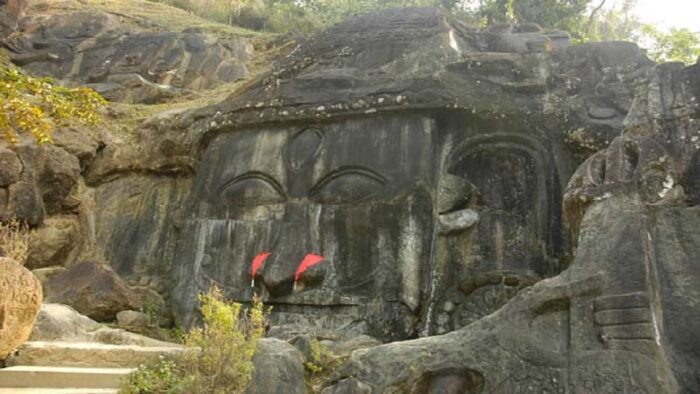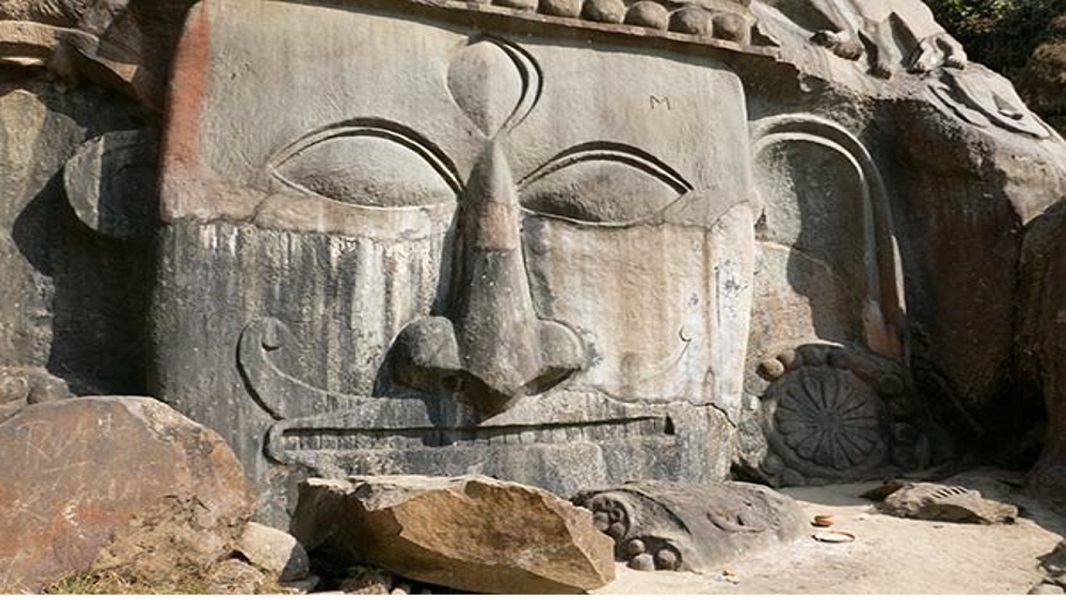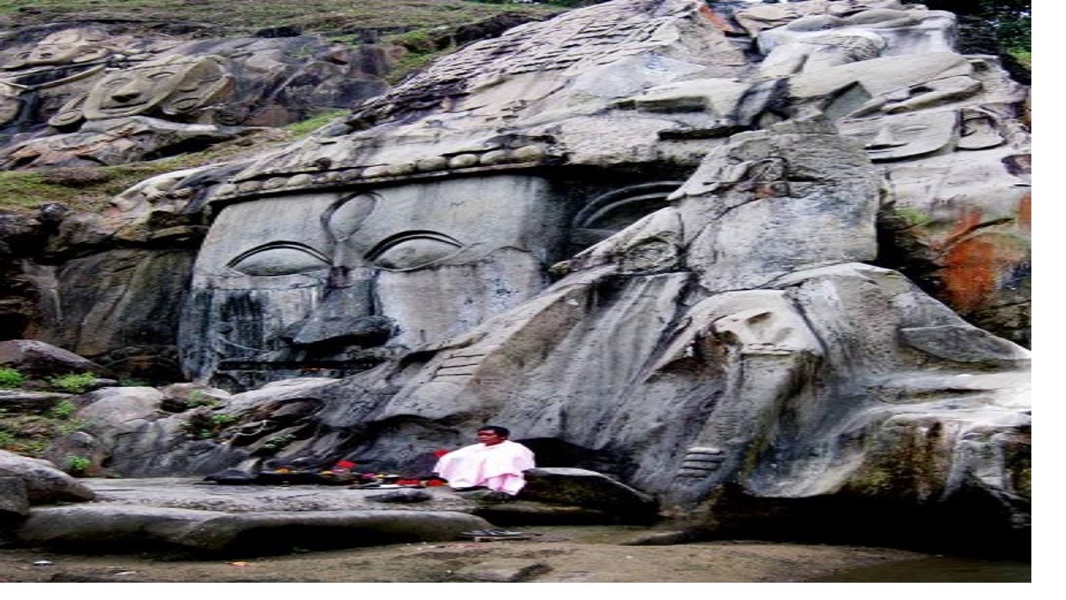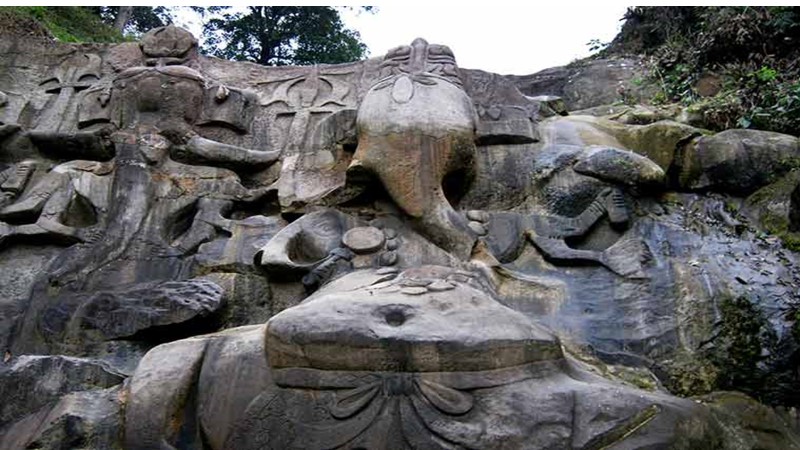Saivism or the worship of the God Siva was a popular sect in India from prehistoric period to present times. In Tripura, too Siva was an important faith from sixth century CE onwards.1 The sect Siva is recognized as the god of destruction in the Vedic triad. He is known to hold the power of concentration of mind and confers skill in accomplishment of arts like music and dancing. Many a myths centering round the god in later scriptures, discloses his two opposite characteristics, viz. the Vedic and the non-Vedic; and the claim of the latter seems to be more valuable, proving his existence felt by the people living outside the Vedic society2. In Tripura, the non-Vedic god worship of Siva might have been prevalent even before the Vedic traditions came into existence. The non-Vedic religion of ancient Tripura centered round the worship of the fourteen gods and goddesses. But Linga worship of the non-Vedic people was not only popular in Tripura, but it had also spreadout throughout the whole region, and influenced the people of neighboring states also.3 The Vratyas4 have proceeded to Tripura from other areas and they absorbed the religious thought of Linga-worshippers in the name of Pas’upata sect.5 It manifests many points of the popular elements of the Yogic Siva claiming the beginning of this sect in the period of the pre-historic civilization.
Tripura is one of the smallest states in the north-eastern India and the region is rich in natural resources and ethnologically interesting as a habitat of several tribal communities such as Tripuris, Riangs, Hālāms, Maghs, Jāmātias, Chākmās, etc. Tripura is bounded in the north, west, and south-east by the international boundary of Bāńgladesh in the present districts of Sylhet, Comilla, Noakhāli, Chittagong, and Chittagong Hill tracts. Geographically, the pre-Māņikya period of Tripura is intertwined with that of ancient Samatata, a region roughly corresponding to the present districts of Sylhet, Noakhāli, and Chittāgong. As a kingdom under the early Māņikya rulers it also included Tipperā (now Comilla, Bāńgladesh) and portions of Sylhet, and in an extended sense it comprised the districts of Noakhāli and Chittāgong. So, the religious history of Tripura prior to the twelfth century CE is mixed up with the religious history of ancient Sylhet, Samatata, Noakhāli and Chittāgong which are now in Bāńgladesh7. The Baghurā inscription of Mahīpāla-1 (988-1038 CE) and Meherpur copperplate of Dāmudār Deva dated 1234 CE clearly established the connection of the Samatata with the districts of Tipperah, Noakhāli and Chittāgong. It is historically true that geographically, Tripura is strategically located in areas of north-eastern India, where diverse civilizations, religions and cultures met in the past. The cross-road of ancient Tripura, it was probably connected with Arakan via land routes through Gomati , Surma and Cachar valley, Lushai hills and Manipur on the one hand and via Chittagong, Arakan on the other8. The ruins of the palace of Manikya King are found from the banks of river Mainee of Chittagong Hill Tract. So, this archaeological evidence proves that this part of Chittagong Hill Tract was under control by the Manikya Kings of Tripura. The Buddhist and Brahmin intellectuals, traders and pilgrims from south-east Asia and Burma would travel through the hill tracts of Arakan, Chittāgong and Tripura9. Gobindra Manikya (1661-1667 CE), the King of Tripura had taken shelter in the Arakan court due turmoil in his motherland and he most probably used the same route. From the northern part of Asia, the Chinese people and different Indo-mongoloid races came from the same route. They spread over the whole of Bramaputra valley and extended to Tripura in the shape of the Tripuri Tribe. The route played an important role in expanding Biharmonical culture or Saivism in Tripura in ancient times. Unakoti, an important Saiva centre of Tripura, is situated in the trade route and it is connected possibly through the land route of upper Burma, and other south-east countries. Unakoti is situated at Kailasahar sub-division of Dhalai district in north Tripura. It is about 180 kilometers north-east from Agartala. It is believed that one less than one crore gods and goddesses are existing in this place, that’s why it is called Unikoti. Jayantan Nath Chaudhury emphasized that Unakoti was a Saiva centre but it was linked with Nathapantha and Tantric Buddhism. Padmanath Bhattacharya mentioned that the rock cut figures were made before Hsung Tsang’s visit to south-eastern Bengal and Hiuen Tsang who visited India in the first half of the seventh century CE. So, the rock-cut figures belonged to seven and eight century CE. But there are no archaeological or literary sources to support these views. According to N.R. Roy, the Unakoti Saiva Centre belonged to the early medieval period. The iconographical character of Unakoti rock-cut figures prove that Unakoti rock-cut figures were made in later than the 12th century CE11. The East India iconographic style at the existence of Unakoti is not a localized phenomenon but the style of the Unakoti sculpture closely followed the idiom of early Bengal. Surma valley and the adjoining tract formed an important segment of Harikela, a geo-cultural region where Unakoti was connected. A trade route existed at the time through this area. A number of rock-cut sculptures are lying over a kilometer at Unokati hill. Besides rock-cut sculptures, a number of sandstone sculptures are scattered here and there and a brick basement of a temple at Unokati hill.10
(Figure 1: Unakotisvara, Kailasahar, Dhalai district in North Tripura)
A unique colossal head image of Siva along with two female attendants appears on either side of the headgear of the god is carved on the rock wall of the Unakoti hills. The local name of the image is Unakotisvara (Plate-1)11. It has a vertically set third eye marked on the forehead, half-moon on the crest and trident, as well as the accompanying figure of the bull, the female figures identified with Durga and Gariga on account of their respective vehicles (simha and makara) lend support to this view. The three eyed deity holds firmly a trident in the middle of the shaft with his grip in the manner which is not found in the classical or medieval representation of Siva of eastern India, though often found in the art of Burma. The rest of his hands are missing. The figure is about 33 inches high, including minutely ornamented head gear which is itself 11 inches in height. The sculpture is carved out of a flat square plane. The divine face with three bulging eyes does not express any mental state of bliss and calmness, as is felt in the images of earlier periods. An interesting feature of the rock-cut of Unakoti lies in the absence of eyebrows in most cases and the specimen under discussion in a relevant illustration. The mouth is a long narrow slit with vertical lines representing teeth, broad ears, like those of an elephant, are decorated with the dheri type of ear ornament of the tribal people of Tripura,12 again a noteworthy feature of the art of Unakoti. The figure has a long moustache turned upwards ending in a loop. The head gear, broken on the top, is interesting, and from what remains it is clear that it is intricately ornamented and not the traditional Jatamukuta of Siva. 13This type of crowning of Siva is absent even in other examples of Unakoti.
This colossal bust of Siva appears to have had a significance in the religious and art history as well as cultural history of Tripura. We are inclined to take the above noted bust as the only surviving record of the influence of the Devaraja sampradaya which was prevalent in medieval Cambodia and adjacent countries.14 The word deva-raja means “god-king” or “king of the gods” in Sanskrit texts. Siva was popular as the king of gods or god king in the Vedic system in the early period. Thus, the mortal kingdom on earth mirrored the celestial kingdom of gods; the concept regarded the king as the living god on earth. The devaraja concept has been established through rituals and institutionalized within the Indianized kingdoms of south-east Asia.
Now as regards to Tripura, though no epigraphical or monumental record testifying to the existence of the said sampradaya has been discovered at Unakoti or in any part of Tripura as yet, certain facts tend to allow us to make presumption that it had penetrated into north-Tripura, possibly through the land route of upper Burma and other south-east countries.15 First Siva is known as ‘The king of gods’ among the tribes of Tripura. Secondly, the Rajamala legends ascribe the foundation of the lunar dynasty of Tripura to one Trilochana (of whom the Manikyas were descendants), who was born by the blessing of Siva16. He was widely venerated by the people as a part of the God Supreme, i.e. Siva. We are told that he has three eyes and the trisula emblem. Evidently this portrait is strongly reminiscent of the devaraja sect and Trilochana was the deified king of Tripura. Thus, the Rajamala tradition indicates the influence of the devaraja concept in Tripura in early medieval times and this seems to be corroborated by the above noted bust of Siva with an ornamented crown instead of the usual jatamukuta17. In this respect one may recall the colossal heads of Lokesvara at Bayon in Cambodia. It is suggested by some scholars as the portrait of the king who is an incarnation of Bodhisattva Lokesvara. The three eyed deity holds firmly a trident in the middle of the shaft with his grip in the manner which is not found in the classical or medieval eastern India, though often found in the art of Burma and Southeast Asia.18
Among the Unakoti sculptures are to be found two representations of Chaturmukha lingas19. Chaturmukha linga, is now worshipped at an elevation of the Unakoti hills. The three faces of Siva are carved on the three sides of its Rudra Bhaga and the back facets damaged. The height of the image is 92 cm. Another Chaturmukha linga of Unakoti has four well carved figures shown up to the waist on four sides of its puja-bhaga. There is uniformity in the four figures of Yogi Siva20. The inscription on this sculpture, the lone example of a sculpture from the pre-Manikya period, consists of a couple of words in the Proto-Bengali character of the eleventh-twelfth century CE. The double curves of the eyebrows on both the Mukhalingas spell out the sensitivity of the eyes which is a characteristic feature of the eleventh and twelfth centuries sculpture of Bengal.
The Ekamukhalinga dated eleventh and twelfth centuries CE is placed on the upward slope of the Unakoti hills. The shape of this Mukhalinga is spherical and the face of Siva is curved on it.
One more important Siva figure of Unakoti, both stylistically and iconographically, is the five faced and ten handed (of which the bull set of right hands is missing), because a snake clings to his body like a sacred thread. All the faces are arranged in a single tier of which the relatively well-preserved central face is prominent. The facial treatment bears an impression of a stamp of south-east Asian idiom and looks like a Javanese sculpture delineating an Indian theme. The god stands with a slight flexion and the body is a little bulky and heavy. The hands and legs are bold and heavy, but less pliable. The garment is tied with a broad waist band. Among the ayudhas, a bow can only be recognised which is clasped in middle with all the five fingers, a mode met within Burmese sculptures.21
(Figure 2: The rock wall of the Unakoti- hills,local name of the image –Unakotisvara of Siva)
Another important significance of the rock-cut of Unakoti is Brahmanical deities were refined to make them acceptable to tribal perception. The choice head, instead of more elaborate Mukhalinga or other form, is indicative of the figure of Siva being altered to fit the tribal deities, for example, the Chaturdasadevata of the Tripuri tribe. They are represented through heads, and their epithets, coupled with associated rituals and non-Brahmin priests clearly establish their tribal character. So, it is no doubt that the Unakati heads are representing of the Chaturdasa Devate22.
Another archaeological record of Sivaism in Tripura is found in Gunaighar, an epigraph of King Vainya Gupta during the first decade of the sixth century CE. This inscription has mentioned that the worship of Siva also passed over to eastern Bengal under the patronage of Maharaja VainyaGupta. The Gunaighar copper-plate23 (507-08 CE.) has mentioned the victorious conquest of Kripura by the king of VainyaGupta, who meditated on the feet of Mahadeva (Mahadeva Padanudhyata). In this record it has mentioned that a demarcation of boundary land of Pradyumnesvara temple was granted by VainyaGupta. Most scholars have taken Pradyumnesvara as a combined from of Hari Hara (Pradyumna and Isvara), i.e. Visnu and Siva. The combination of Hari and Hara in one image forms the theme of this icon. In this aspect, both Siva and Visnu are united in one image. The iconographic detail of the image is given in Vamana-purana as quoted in Sabdakalpadruma. The Gunaighar inscription seal has been engraved a bull and it is the vehicle of Siva24.
The Asrafpur plates25 point to the special favour offered by the Buddhist kings of the Khadga dynasty of Samatata in the seventh century CE. Each of these plates bear a royal seal which contains in relief the figure of a couchant bud along with the legend Srimad Devakhadga. It evidently shows that the growing popularity of Saivism even attached the mind of the Buddhist Khadga rulers. Moreover, the Saiva leaning of the Tills royal dynasty is known from another inscription, where Prabhavati, the queen consort of Devakhadga, is said to have covered an image of Sarvani with gold. Sarvani is the Sakti of Sarva, one of the eight distinctive forms of Rudra mentioned in the Atharva-Veda. That Sarvani is the Sakti of Siva is also corroborated by a verse in the Khalimpur copper-plate of Dharmapaladeva, where Sarvani is clearly called the wife of Siva. The Tippera grant of Lokanatha shows that the ancestors of Lokanatha were devotees of Sankara. It is a parallel instance proving ardent devotion of a reigning king of Tripura towards Siva26.
(Figure 3: Twelve handed Nataraja, Khowai district, North Tripura)
A unique image of a twelve handed Nataraja of the eleventh the twelfth centuries CE was found at Khowai north Tripura district.27 It is now a private collection but is regularly worshipped. The relief under study portrays Siva Nataraja as dancing on the back of his bull mount Nandi in the chatura mode of dance in which the left leg is raised, although the toes touch the base, here the back of the animal. The divine dancer is endowed with twelve hands and the usual urdhvalinga ithyphallic trait.28 Siva Nataraja holds up a snake by his uppermost pair of hands, exhibits a mudra-hand pose, marking the time above his head by the next pair of hands and playing on a Vina lyre by the normal right and left hands, but it is not clear whether he uses any metal bar for setting the pitch. The remaining right hands of the god (from above) shows a kettledrum, a pasa (noose) and akshasutra (rosary) and the remaining left hands, also from above, shows a kapala (skull-cup), a trisula (trident) and a kamandalu (water vessel)29 .
So far, four twelve armed specimens of Siva Nataraja of the Khowai type have been found, and all the Siva Natarajas are made of stone. All Siva Natarajas are founded from Outshahi, (Dhaka district), Uttar Raikhal (Dhaka), Maniari (Rajshahi) and Durgapur (Chittagong) in Bangladesh30. The first two are kept in the Bangladesh National Museum at Dhaka, the third at the Varendra Research Museum at Rajshahi while the fourth is in the Indian Museum in Calcutta. The Asutosh Museum of the Calcutta University has in its collection, a sculptural specimen of the twelve handed image, but its upper part having been lost, it is not possible to say anything about the position of the upper hands. Further, in this image the divine dancer is accompanied by Nandi and Bhringi, instead of Gauri and Gariga, or Gariga and Yamuna, as seen elsewhere. The twelve handed specimens of Siva Nataraja of the Bengal school are thus five,31 including the present image, now under worship at a private residence at Khowai.
Images of Siva as a cosmic dancer discovered within the geographical limits of undivided Bengal spell out a distinctive icono-plastic diction. They admit of different varieties in respect of the number of hands, which vary from eight to twelve and other iconographic features but in each instance, Siva is seen as invariably dancing on the back of his mount, Nandi. In general, the bull is depicted as standing, either facing right or left, and rarely seated. The Siva on the bull type of Nataraja images originated most probably in West Bengal in the early part of the tenth century CE, following which it migrated to East Bengal and the neighboring regions of Assam and Orissa. The bull Nataraja image also migrated to Nepal and Vietnam32.
(Figure 4 – The rock-cut Ganesa of the Unakoti- hills)
Typologically, the Khowai image shares the features of the examples of the Bengal school. It has its own distinctive character and is not exactly identical with the other four icons of the twelve handed type. The Khowai image differs from the rest in the position of the bull, while the animal faces right in the other three, it faces left in the present image. The Siva-Natraja image of Khowai town of Tripura is a significant example of the collection of the Nataraja figures of the Bengal school, and it was either imported from the Comilla region of the present Bangladesh, or was shaped by a local artist who was once a member of Comilla group or was earlier conversant with the iconoclastic diction expressed by the Siva-Nataraja images of the Bengal School.33
References
- Tripura District Gazetteers ,1975, p- 388. And also see— cencusreport of tripura .com
- Chatterjee, Roma, Religion in Bengail, p-132.
- Ganchaudhri, j, Tripura; The Land and its People,1980, p-60 .
- Majumder, R.C, History of Bengal, Vol. 1, Calcutta,1971, p404
- Bhanderkar, R.G, Vaisnaism, Saivism and other Minor Sects, p-103
- cencusreport of tripura.com
- Palit, K. Projit (2004 ), History of Religion in Tripura, New Delhi, pp – 46 )
- Palit, K. Projit (2004) op. cit, p-15
- Mukherjee, B.N, (1992), External Trade Of Early North Eastern India, New Delhi, p- 24.
- Das, R, Art & Architecture of Tripura, Agartala, pp-44-45
- Palit, K. Projit (2004) op.cit, p-88
- Das, R, Art & Architecture of Tripura, Agartala, p-46
- Palit, K. Projit (2004) op.cit, p-89
- Das, R, Art & Architecture of Tripura, Agartala, p47
- Palit, K. Projit (2004) op.cit, p- 90
- Hunter, w. w, StatisticalAccount of Bengal, Delhi, 1973, Vol.VI,pp-463-64
- Palit, K. Projit (2004) op.cit,p -91
- Ibid,p -92
- ASR, XXI, p-33
- Das, R, Art & Architecture of tripura, Agartala, p-47
- Palit, K. Projit (2004) op.cit, p- 90
- Ibid,p -91
- Q.X, P-57
- Chatterjee, B, Culture of Bengal Through the Ages, p-49.
- Sen, B. C. Some Historical Aspects of the Inscriptions of Bengal, P-xvii
- El, XV, 1919-20,p-301
- Bhattasali, N, K,Catalogue of the Buddhist andBrahmanical Sculptures in DaccaMuseum, pp-112-13
- Ganchaudhri, j, Tripura; The Land and its People,1980, p-60 .
- Palit, K. Projit (2004) op.cit, p- 93
- Ray, Jagat Jyoty, Rajendra kirtishalar silver jubilee commemorative volume, p-44.
- Ibid,p -45
- Palit, K. Projit (2004), op.cit, p- 92
- Ibid,p -93
Watch video presentation of the above paper here:
Disclaimer: The opinions expressed in this article belong to the author. Indic Today is neither responsible nor liable for the accuracy, completeness, suitability, or validity of any information in the article.













